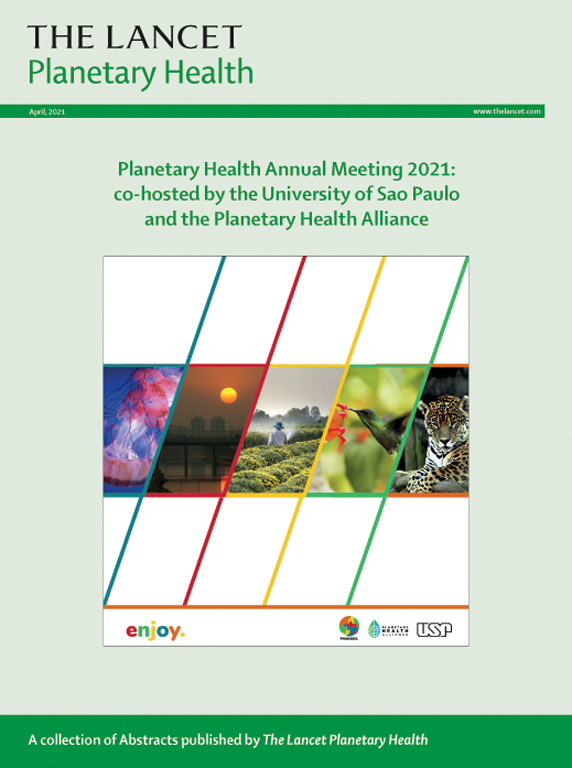欧洲城市树冠覆盖对空气污染相关死亡率的影响:一种综合方法
IF 21.6
1区 医学
Q1 ENVIRONMENTAL SCIENCES
引用次数: 0
摘要
在城市地区,细颗粒物(PM2·5)、二氧化氮(NO2)和对流层臭氧(O3)是对人体健康危害最大的空气污染物。城市绿化被视为一种有利于空气质量、气候和市民福祉的策略。我们的目的是估计树木覆盖的变化,归因于空气污染的死亡率负担,以及可能通过增加欧洲城市的树木覆盖来预防的死亡率。方法我们进行了定量健康影响评估,以估计平均树木覆盖对36个国家744个欧洲城市中心的空气污染物水平以及与pm2.5相关、与no2相关和与o3相关的死亡率(所有年龄段)的影响。我们在全市范围内进行了分析。2000年至2019年期间,平均树木覆盖率增加了0.76个百分点,其中73.5%的城市中心树木覆盖率更高,而所有城市中心的死亡率负担平均下降了3.39%(标准差0.28)。2019年,约25%的人口生活在平均树冠覆盖率超过30%的地区。与目前的树木覆盖率相比,林冠覆盖率每增加5个百分点,可使空气质量的年平均PM2·5浓度提高2.8%,年平均NO2浓度提高1.4%,夏季最大8-h O3浓度提高1.2%。我们估计,在744个欧洲城市中心,树冠每增加5个百分点,每年就有可能防止4727例与空气污染有关的过早死亡(95% CI 2067-7475)。我们还估计,每个城市的树冠覆盖率达到30%,每年有可能防止11974人过早死亡(95% CI 7775 - 14390)。我们的研究结果强调了增加城市环境中树木覆盖率的潜在公共健康益处,有助于可持续、宜居和更健康的城市。欧盟人寿保险金融工具;罗马尼亚国家研究局;科学部房地产署Investigación Innovación;Generalitat Valenciana;欧洲区域发展基金;国家自然科学基金。本文章由计算机程序翻译,如有差异,请以英文原文为准。
Effect of tree canopy cover on air pollution-related mortality in European cities: an integrated approach
Background
In urban areas, fine particles (PM2·5), nitrogen dioxide (NO2), and tropospheric ozone (O3) are the most harmful air pollutants for human health. Urban greening is seen as a strategy for co-benefitting air quality, climate, and citizens’ wellbeing. We aimed to estimate the changes in tree cover, the mortality burden attributable to air pollution, and the mortality that could be potentially prevented by increasing tree coverage in European cities.
Methods
We did a quantitative health impact assessment to estimate the effect of mean tree cover on air pollutants levels and PM2·5-related, NO2-related, and O3-related mortality (all ages) in 744 European urban centres, with more than 50 000 inhabitants, across 36 countries. We did all analyses at the city-wide scale.
Findings
Between 2000 and 2019, the mean tree coverage increased by 0·76 percentage points, with 73·5% of the urban centres showing greener coverage, whereas mortality burdens declined by on average 3·39% (SD 0·28) in all urban centres. In 2019, about 25% of the total population lived in areas with a mean tree canopy coverage over 30%. Compared with the current tree cover, each five percentage point increase in tree canopy cover could facilitate an air quality improvement of 2·8% for annual PM2·5 mean concentrations, 1·4% for annual NO2 mean concentrations, and 1·2% for summertime mean of the daily maximum 8-h O3 concentrations.
Interpretation
We estimated that each five percentage point increase in tree canopy would potentially prevent 4727 premature deaths (95% CI 2067–7475) related to air pollution annually across the 744 European urban centres. We also estimated that reaching a canopy cover of 30% within each city could potentially prevent 11974 premature deaths (95% CI 7775–14 390) each year. Our results highlighted the potential public health benefits of increasing tree coverage in urban environments, contributing to sustainable, liveable, and healthier cities.
Funding
LIFE financial instrument of the EU; Romanian National Research Authority; Agencia Estatal de Investigación, Ministerio de Ciencia e Innovación; Generalitat Valenciana; The European Regional Development Fund; and National Natural Science Foundation of China.
求助全文
通过发布文献求助,成功后即可免费获取论文全文。
去求助
来源期刊

Lancet Planetary Health
Multiple-
CiteScore
28.40
自引率
2.30%
发文量
272
审稿时长
8 weeks
期刊介绍:
The Lancet Planetary Health is a gold Open Access journal dedicated to investigating and addressing the multifaceted determinants of healthy human civilizations and their impact on natural systems. Positioned as a key player in sustainable development, the journal covers a broad, interdisciplinary scope, encompassing areas such as poverty, nutrition, gender equity, water and sanitation, energy, economic growth, industrialization, inequality, urbanization, human consumption and production, climate change, ocean health, land use, peace, and justice.
With a commitment to publishing high-quality research, comment, and correspondence, it aims to be the leading journal for sustainable development in the face of unprecedented dangers and threats.
 求助内容:
求助内容: 应助结果提醒方式:
应助结果提醒方式:


